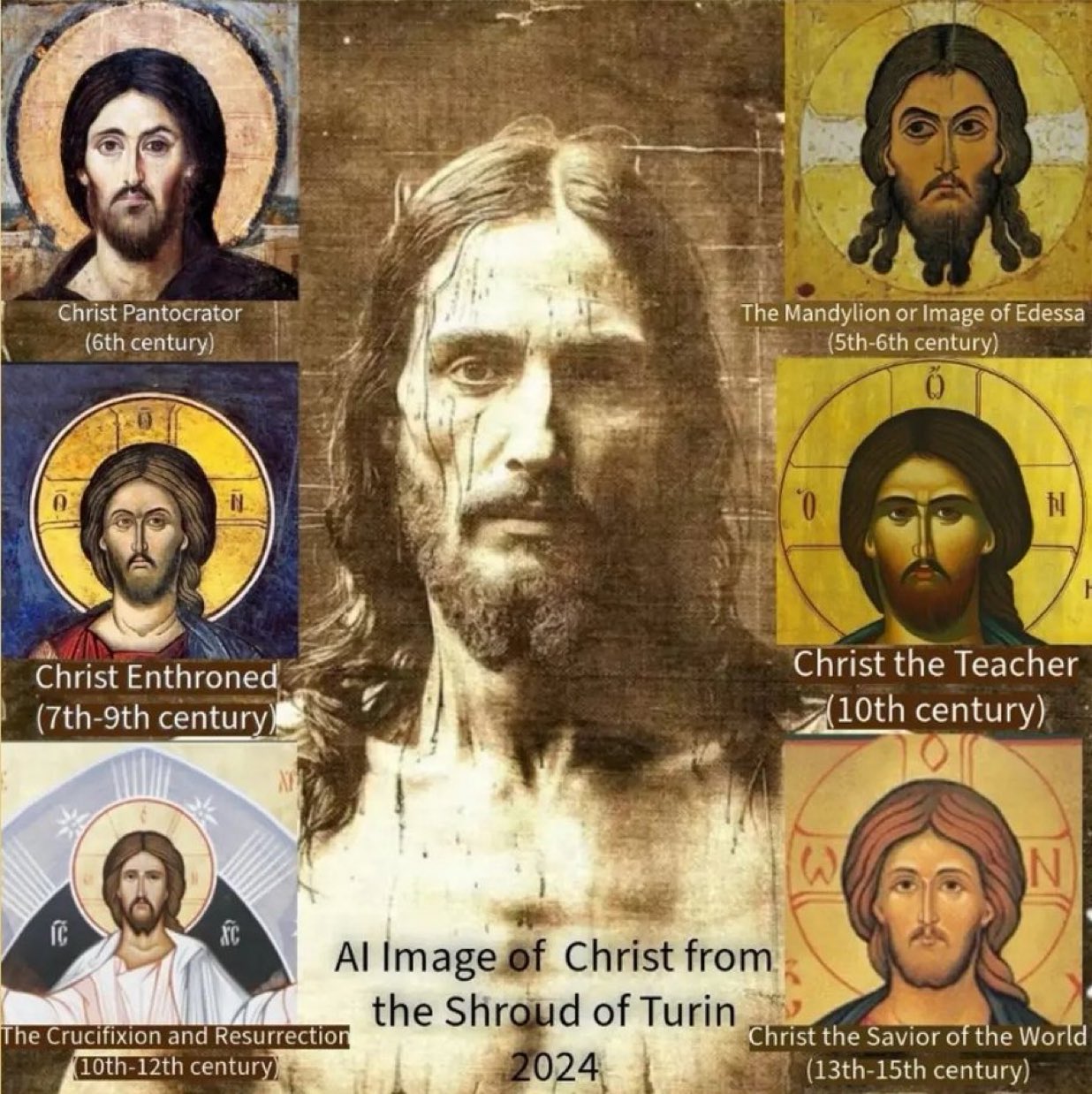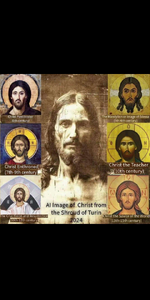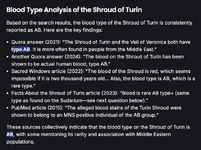I found a thread on X about the Shroud of Turin being proven to be from the Middle East in the 1st Century AD, and was curious if there were any other similar artifacts.
You are using an out of date browser. It may not display this or other websites correctly.
You should upgrade or use an alternative browser.
You should upgrade or use an alternative browser.
Shroud of Turin
- Thread starter Giordano Bruno
- Start date
I just saw this and came to post it. It is a great read.
Muh Mulatto Caveman Jesus.
I noticed in the last 15 years or so Evangelical depictions of Jesus always make him look like a Mexican landscaper or an Arab. It’s probably an overreaction to the Blond Anglo-Saxon Girly Jesus that dominated for a while, but the reality is what we see in the Sinai Pantocrator icon, which actually looks consistent with real people from Palestine, to boot.
I noticed in the last 15 years or so Evangelical depictions of Jesus always make him look like a Mexican landscaper or an Arab. It’s probably an overreaction to the Blond Anglo-Saxon Girly Jesus that dominated for a while, but the reality is what we see in the Sinai Pantocrator icon, which actually looks consistent with real people from Palestine, to boot.
The Sinai Pantocrator always looked really Arab to me. But its better than the rest which tend to make Him look Greek or Chinese.Muh Mulatto Caveman Jesus.
I noticed in the last 15 years or so Evangelical depictions of Jesus always make him look like a Mexican landscaper or an Arab. It’s probably an overreaction to the Blond Anglo-Saxon Girly Jesus that dominated for a while, but the reality is what we see in the Sinai Pantocrator icon, which actually looks consistent with real people from Palestine, to boot.
I'm a Near Eastern Christian and, having grown up alongside many other Near Eastern Christians I can say that this question of depiction and representation never entered our minds, nor the minds of our parents and grandparents. It a very American, or should I say (((American))) fixation and controversy.
Consider the Our Lady of Lebanon statue. It would be considered too "European" or "White" by these same malcontents and subversives.

Consider the Our Lady of Lebanon statue. It would be considered too "European" or "White" by these same malcontents and subversives.

I remember there was a similar thread on RVF about this.
In short the conclusion was the shroud was a kind of miracle, as proof of our Lord's death and resurrection. Of course we must believe in The Lord based on our faith, but He allows limited miracles such as this to make us believe in Him.
Since through conventional means, there was simply no way the image of Jesus could be burned into the linen.
In short the conclusion was the shroud was a kind of miracle, as proof of our Lord's death and resurrection. Of course we must believe in The Lord based on our faith, but He allows limited miracles such as this to make us believe in Him.
Since through conventional means, there was simply no way the image of Jesus could be burned into the linen.
Perseus66
Protestant
the reality is what we see in the Sinai Pantocrator icon
Be careful here, the Sinai Pantocrator was crafted five centuries (!) after incarnated Christ died. Jesus didn't necessarily look like your average 6th century Middle Eastern man. It's just a belated depiction, we can't know for sure. Demographics can change drastically over centuries, even decades (just look at today's Europe).
Be careful here, the Sinai Pantocrator was crafted five centuries (!) after incarnated Christ died. Jesus didn't necessarily look like your average 6th century Middle Eastern man. It's just a belated depiction, we can't know for sure. Demographics can change drastically over centuries, even decades (just look at today's Europe).
Yes, but we can assume that it was an image based on previous images in the 1st, 2nd, 3rd, 4th, and 5th centuries, so there must be a degree of truth to Christ's Middle Eastern Jewish ancestry.
In the 6th century they had access to far more information than we do today: it was the height of the Byzantine Empire and most of the knowledge they had back then has been lost to time.

Two Reasons Evangelicals Reject the Shroud of Turin - Orthodox Reflections
The vehemence with which Evangelicals reject the authenticity of the Shroud of Turin can be surprising. Their faith is at stake.
 orthodoxreflections.com
orthodoxreflections.com
Eh, I got a friend who believes the shroud is authentic. It doesn't change his belief in the second commandment or Scriptural sufficiency.
Two Reasons Evangelicals Reject the Shroud of Turin - Orthodox Reflections
The vehemence with which Evangelicals reject the authenticity of the Shroud of Turin can be surprising. Their faith is at stake.orthodoxreflections.com
He even convinced an atheist friend of his that the shroud is authentic. The atheist believes the shroud is authentic, believes that Jesus really rose from the dead. Doesn't change that he would still spit in Jesus' face if given the chance, per his own words.
Muh Mulatto Caveman Jesus.
I noticed in the last 15 years or so Evangelical depictions of Jesus always make him look like a Mexican landscaper or an Arab. It’s probably an overreaction to the Blond Anglo-Saxon Girly Jesus that dominated for a while, but the reality is what we see in the Sinai Pantocrator icon, which actually looks consistent with real people from Palestine, to boot.
The fact that the church accepts this image is a very important thing to take note of, if you want an accurate icon of Christ the best place to get it is from the members of the club, the churchBe careful here, the Sinai Pantocrator was crafted five centuries (!) after incarnated Christ died. Jesus didn't necessarily look like your average 6th century Middle Eastern man. It's just a belated depiction, we can't know for sure. Demographics can change drastically over centuries, even decades (just look at today's Europe).
An important thing I want to mention, Christ is not black nor white (although He looked quite white), He is olive skinned and came from the line of the Hebrews, David, these Hebrews are like one of the smallest population groups in the world and the race of these people dont even accept Christ so they dont even boast about God in the flesh being of "their" race, I find this quite facinating and I see the wisdom of God in these events and the race of people He came into the world through.


It makes sense that if the resurrection is true, the followers would have kept the cloth. Not only to show people He had risen, but out of reverence too. Sure the medieval church faked some stuff, but it doesn't mean this particular relic is fake. I don't rest my faith on it, but it is quite compelling.
I do find it funny that believers in the resurrection will say its a bit far fetched that the burial shroud would have been preserved.
I do find it funny that believers in the resurrection will say its a bit far fetched that the burial shroud would have been preserved.
Off topic but I just find it bizarre that this guy could believe in Christ's resurrection but still refuse to accept the Gospel considering that the resurrection being true collaborates and gives a stamp of divine approval to Christ's teachings and claims. What's the guy's reasoning?He even convinced an atheist friend of his that the shroud is authentic. The atheist believes the shroud is authentic, believes that Jesus really rose from the dead. Doesn't change that he would still spit in Jesus' face if given the chance, per his own words.
Last edited:
He doesn't have one. He's just an example of Romans 1. Whether they know God exists or not is beside the point, the Bible says they do know. They hate God and suppress the truth in unrighteousness.What's the guy's reasoning?
Even when I was protestant they used to teach that the head covering of Christ head was a seperate piece of clothe from the body and that when Christ resurrected the burial clother was folded by Christ but the part that covered His head was left untouched so it was still in the shape of Christs head, they quoted the part of the scripture where Peter ran to the tomb and when He saw it he believedIt makes sense that if the resurrection is true, the followers would have kept the cloth. Not only to show people He had risen, but out of reverence too. Sure the medieval church faked some stuff, but it doesn't mean this particular relic is fake. I don't rest my faith on it, but it is quite compelling.
I do find it funny that believers in the resurrection will say its a bit far fetched that the burial shroud would have been preserved.
Are there any healings associated with the shroud? From just an initial look it seems like it entered into public consciousness at the dawn of "science world" in the late 1300s.
But I did find some possible earlier info:
Historical records dating back to at least the 6th century refer to a cloth with an imprint of Jesus. “These references seem to center on one particular cloth which had been taken to Edessa [now in Eastern Turkey] back in the first century AD,”
“It was immediately hailed as being a miraculously imprinted likeness of Jesus and it became known as the Cloth of Edessa,” “It was not called a shroud, but it became very celebrated. Artists made their likenesses of Jesus from it.”
In 944, the Edessa Cloth was removed from the city by the armies of Emperor Romanus I of Constantinople. “He had a collection of relics of Jesus, things like the nails from the cross,” “He wanted this cloth to join them,” The Edessa Cloth remained in Constantinople until 1204, when Crusaders sacked the city.
....the Edessa Cloth and the Shroud of Turin could very well be one and the same.
apologies it's sourced from PBS:

 www.pbs.org
www.pbs.org
But I did find some possible earlier info:
Historical records dating back to at least the 6th century refer to a cloth with an imprint of Jesus. “These references seem to center on one particular cloth which had been taken to Edessa [now in Eastern Turkey] back in the first century AD,”
“It was immediately hailed as being a miraculously imprinted likeness of Jesus and it became known as the Cloth of Edessa,” “It was not called a shroud, but it became very celebrated. Artists made their likenesses of Jesus from it.”
In 944, the Edessa Cloth was removed from the city by the armies of Emperor Romanus I of Constantinople. “He had a collection of relics of Jesus, things like the nails from the cross,” “He wanted this cloth to join them,” The Edessa Cloth remained in Constantinople until 1204, when Crusaders sacked the city.
....the Edessa Cloth and the Shroud of Turin could very well be one and the same.
apologies it's sourced from PBS:

Shroud of Christ? ~ Background | Secrets of the Dead | PBS
The history of the Shroud of Turin presents an interesting contrast. Over the past several centuries, every movement, study, and display of the cloth has



